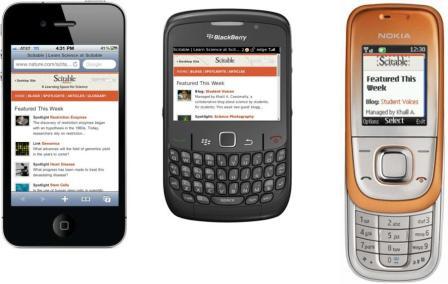Nature's Scitable: Going Mobile
Why Scitable Chose a Mobile Web Strategy Over a Mobile App Strategy for Its First Mobile Initiative
What’s the best mobile strategy to embrace if you want to reach mobile users around the world and get optimized search placement? That’s the question Nature Education’s Scitable division tackled as they embarked on their first mobile web initiative. They chose a mobile web approach over a mobile apps approach in order to reach cell phone users on basic phones as well as smart phones.
NETTING IT OUT
Nature Education’s Scitable.com is an innovative platform that provides authoritative and free scientific educational materials to students and faculty around the world. Many of Scitable’s users are located in developing countries and/or in rural areas where direct Internet access from a computer is problematic. That’s why in 2010 the Scitable team decided to add a mobile delivery strategy for its scientific content: Let students around the world access this valuable content via their mobile phones.
How did the Scitable management, development, and editorial teams decide which mobile strategy to pursue first? Why did they choose to roll out a mobile web strategy instead of creating mobile apps for their first efforts? And, having decided to go with a mobile web approach, why didn’t they create special-purpose Mobile web sites? That’s what most businesses do. The answer: Scitable didn’t want to adversely impact its search rankings by diluting its “Google Juice” across multiple, nearly identical, sites.
Š Scitable.com, Nature Education
The Scitable web site is designed to be really fast and functional on all of these different form factor phones. It’s a single web site. But each phone/browser combination is detected “automagically,” and the right format and image resolution and video formats are served up.
SCITABLE.COM: REPLACING SCIENTIFIC TEXTBOOKS WITH INTERACTIVE DIGITAL TOOLS & CONTENT
Interactive Web Site Is a New Way to Access Scientific Learning Materials
Scitable.com was launched in 2009 to revolutionize the scientific textbook publishing industry. Instead of buying $150 textbooks for each university science course, Nature Education offers students and professors a free resource of authoritative, up-to-the-minute, and well-designed learning materials. Scitable.com provides self-guided learning paths, online classrooms, and a community of scientists and researchers who answer students’ questions. Today, university, college, and high school students from almost 200 countries use Scitable’s authoritative and current material to learn about genetics and cell biology. Over the next several years, Nature Education plans to release learning materials for all of the life sciences and many of the physical sciences.
One of the early learnings for Nature Education was the appeal of its content to a global audience of professors, researchers, undergraduate students, and graduate students. Of the tens of thousands of people who have signed up to use Scitable.com, the majority of them are not in North America—roughly a third of the faculty and students who use Scitable.com come from Asia, Africa, South America, and the Middle East.
Scitable.com is currently funded by corporate sponsorships. The sponsors are interested in creating brand awareness among life science students; not in selling promoting products to them or in influencing the content. Vikram Savkar, SVP of Nature Education and Publishing Director of Scitable, explains: “The sponsors want to create brand awareness; not to sell their products. The section on the site where we thank our sponsors explains that sponsors have nothing to do with the content. We make sure that we avoid any controversy. It is incumbent upon us to be transparent.” Current sponsors include: Alnylam Pharmaceuticals, Intel, New England BioLabs, Roche Applied Science, and Tata Consultancy Services.
Do Students Need Access to Online Learning Materials from Their Mobile Phones?
What made the Scitable team think that faculty and students needed mobile access to Scitable’s resources? “We stake our identity on pushing worldwide science education. Accessibility is key. There is no access to computers in rural areas in poorer nations. But the students do have mobile phones in the developing world. To be truly global is to be mobile,” Vikram explained.
Vikram also told me that mobile is increasingly important in the U.S. as well. For example, many of the students who use Scitable in their studies in the U.S. are parents who spend much of their days driving their kids to and from school and to various after school activities. Many of these parents are also taking courses in order to improve or to switch their careers. These parents spend a lot of time in their cars—often waiting for kids in the parking lot. If they can do their homework by reading course material on their mobile phones while sitting in a car, that’s precious time that would otherwise be wasted.
THE DECISIONS THE SCITABLE TEAM NEEDED TO MAKE ABOUT THEIR MOBILE STRATEGY
One of the things I learned from talking with the Scitable team is that if you are planning or refining a mobile strategy for your content or your web site, there are a number of key decision points. I suspect that these decision points (and the order in which you need to address them) may be similar for most people contemplating their mobile strategies. Here are some of the decisions that Vikram Savkar; Michael Powers, Scitable’s Executive Product Manager; and their team of developers and editors had to make along the way...
Sign in to download the full article
0 comments
Be the first one to comment.




